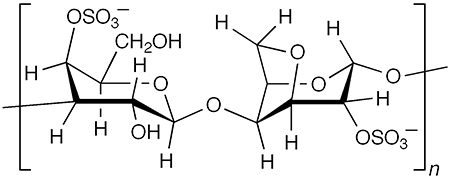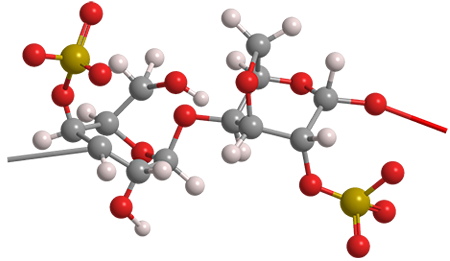What molecules are we?


The carrageenans are a group of linear sulfated polysaccharides found in red algae1 of the phylum Rhodophyta. At least 10 carrageenans are known; the best known and most important ones are ι (iota)-, κ-2, and λ-3carrageenan. The ι-form, shown here, is found primarily in the alga Eucheuma denticulatum.
All carrageenan polymers consist of repeating units of galactopyranose disaccharides, each of which contains zero, one, two, or three sulfate groups. The counterions of the anionic carrageenans are typically sodium, potassium, and/or calcium. ι- and κ-carrageenan occur in double-helix conformations.
In 1946, E. Gordon Young and F. A. H. Rice at Dalhousie University (Halifax, NS) were among the first to describe carrageenans in the chemical literature (then by the name carrageenin), although they cited references to them as far back as 1844. About the same time, C. K. Tseng at the Scripps Institute of Oceanography (La Jolla, CA) also wrote extensively about carrageenin and other algae-derived compounds.
Historically, carrageenans have been used as thickening, gelling, emulsifying, stabilizing, and clarifying agents in food products ranging from ice cream to beer. They are also additives to common household products such as toothpaste, shampoo, air fresheners, and shoe polish. The three major carrageenans have widely different gelling properties: Calcium ι-carrageenan forms soft gels; potassium κ-carrageenan forms rigid gels; and the λ-structure does not gel at all.
In the past decade, scientists have studied carrageenans for what could turn out to be even more important uses: antiviral medications. In 2020, a few months into the COVID-10 pandemic, Leonel Pereira at the University of Coimbra (Portugal) and Alan T. Critchley at Cape Breton University (Sydney, NS) posed the question, “seaweeds4 to the rescue?” and wondered why the pharmaceutical community hadn’t investigated building on the known antiviral properties of carrageenans and other algae molecules to combat SARS-CoV-2, the virus responsible for COVID-19.
Among several studies they cited, Pereira and Critchley noted that an ι-carrageenan-containing nasal spray provided relief of upper respiratory tract infections in patients suspected of having H1N1 influenza. They also observed that the initially low levels of COVID-19 infection in Hokkaido Island (Japan) might be attributed to the residents’ widespread consumption of seaweed.
Scientists soon took up the challenge. The following year, Hafiz M. N. Iqbal at the Monterrey Institute of Technology and Higher Education (Mexico), Jingliang Xu at Zhengzhou University (China), and collaborators further reviewed literature that suggested that carrageenans and other algae molecules could prevent and treat SARS-CoV-2 infection. In another review, Manu Kumar at Dongguk University (Seoul) and colleagues noted that sulfated polysaccharides such as carrageenans attach tightly to the SARS-S protein, resulting in reduced viral infection.
In a 2021 breakthrough, Andrea Vanesa Dugour and co-workers at the University of Buenos Aires and the César Milstein Institute of Science and Technology (Buenos Aires) discovered that ι-carrageenan prevents the replication of SARS-CoV-2 in vitro in the human respiratory epithelium cell line Calu-3. They used the same formula as in the already-approved nasal spray mentioned above.
A ScienceDirect information page provides much more information on ι-carrageenan. The Prospector Knowledge Center published an excellent compendium of the three main carrageenan structures.
1. This year’s theme for Chemists Celebrate Earth Week is “The Curious Chemistry of Amazing Algae”. MOTW is proud to participate in the celebration.
2. CAS Reg. No. 11114-20-8.
3. CAS Reg. No. 9064-57-7.
4. “Seaweed” is a common term for macroalgae.
ι-Carrageenan fast facts
| CAS Reg. No. | 9062-07-1 |
| SciFinder nomenclature | ι-Carrageenan |
| Empirical formula | (C12H16O15S22–)na |
| Molar mass | ≈200–300 x 103 g/mol |
| Appearance | White, tan, or yellow solid |
| Melting point | ≈60 °C |
| Water solubility | Solubleb |
a. As shown in images.
b. Sodium salt; others are water-soluble only at elevated temperatures.
ι-Carrageenan
hazard information
| Hazard class* | GHS code and hazard statement |
|---|---|
| Not a hazardous substance or mixture |
*Globally Harmonized System (GHS) of Classification and Labeling of Chemicals.
MOTW update
Cannabidiol1 (CBD) was the Molecule of the Week for February 6, 2017. It is a non-psychoactive marijuana constituent that is useful for controlling pain and other medical conditions. Perfluorooctanesulfonic acid2 (PFOS) was the Molecule of the Week for January 28, 2019. It was once a widely used surfactant; but because it became an environmental pollutant—even appearing in human blood—it was removed from the market.
What’s the connection between CBD and PFOS? Earlier this month, Hang Yin, Shu Li, and co-workers at Northeast Agricultural University (Harbin, China) reported that administering CBD can attenuate PFOS-induced heart injury. In a mouse study, the researchers found that CBD alleviates myocardial cell apoptosis caused by PFOS by restoring antioxidant capacity, mitochondrial function, and energy metabolic homeostasis to the cells.
1. CAS Reg. No. 13956-29-1.
2. CAS Reg. No. 1763-23-1.

Learn more about this molecule from CAS, the most authoritative and comprehensive source for chemical information.
Molecule of the Week needs your suggestions!
If your favorite molecule is not in our archive, please send us a message. The molecule can be notable for its current or historical importance or for any quirky reason. Thank you!
Stay Ahead of the Chemistry Curve
Learn how ACS can help you stay ahead in the world of chemistry.

